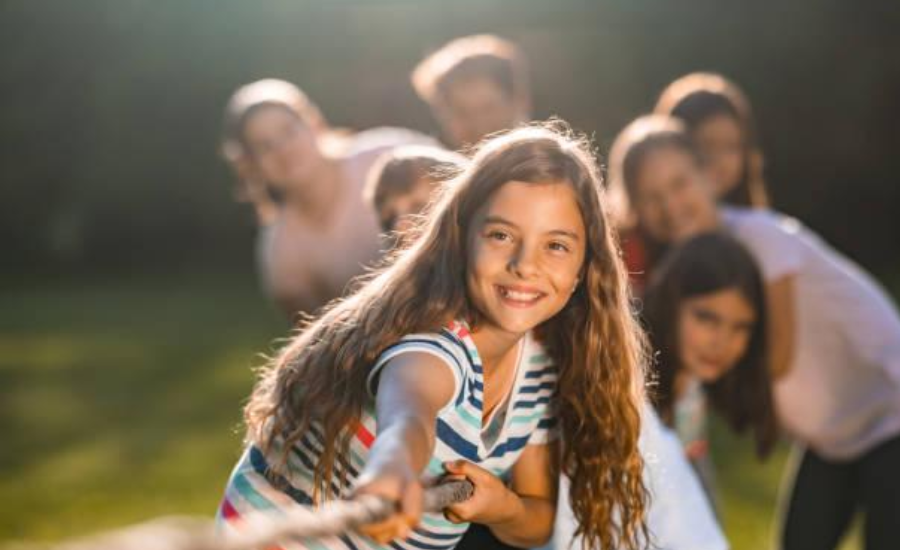Summer camp is all about fun, adventure, and learning, but one of the most impactful takeaways for campers is often the relationships they form and the teamwork they develop. Teamwork builds confidence, encourages communication, and helps campers develop important life skills. That’s where Team-Building Exercises come into play. These activities allow campers to bond while working together toward a common goal. Whether you’re a camp director, or counselor, or planning activities for a group, incorporating team-building exercises can make the experience even more memorable.
In this blog, we’ll dive into some fun and effective Team-Building Exercises you can organize at camp. These activities are designed to promote cooperation, leadership, and trust—all while making sure campers have a blast!
The Benefits of Team-Building Exercises at Camp
Before jumping into specific activities, it’s helpful to understand why Team-Building Exercises are so valuable in a camp setting. Camps bring together kids from diverse backgrounds, many of whom may not know each other. Team-building activities provide a structured way for campers to bond, communicate, and feel more comfortable in their new environment. The benefits of team-building include:
Enhanced Communication Skills: Team-building activities require campers to listen to one another, share ideas, and collaborate.
Building Trust and Cooperation: These exercises encourage campers to rely on their peers and work together to succeed.
Increased Confidence: Completing a challenging activity as part of a team can give campers a sense of accomplishment and boost self-esteem.
Leadership and Problem-Solving: Many team-building exercises offer opportunities for campers to take leadership roles and develop problem-solving skills.
Now, let’s explore some great activities that can be easily incorporated into any camp program.
1. Spider Web Challenge
The Spider Web Challenge is a classic Team-Building Exercise that encourages campers to work together and communicate effectively. The goal is to pass campers through a “spider web” without touching the strings.
How to Play:
Create a “spider web” using rope tied between two trees or poles. Ensure that the web has different-sized openings for campers to pass through.
The challenge is for each camper to pass through a different hole in the web without touching the ropes. If anyone touches the web, the whole team starts over.
Teams must strategize and work together to lift and guide each other through the openings.
This activity is excellent for teaching cooperation and trust, as campers have to physically assist one another. It also helps them practice problem-solving, as they figure out the best way to get everyone through the web.
2. Trust Fall Circle
Trust is a foundational element of teamwork, and the Trust Fall Circle is a simple yet powerful way to build it among campers. This exercise requires campers to let go of control and trust their peers to catch them.
How to Play:
Have campers form a circle, standing shoulder to shoulder.
One camper stands in the center of the circle, crosses their arms over their chest, and closes their eyes.
The camper in the center slowly falls backward in a random direction while the campers in the circle gently push them back upright.
Rotate so each camper gets a turn in the center.
The Trust Fall Circle helps campers build trust in a fun and supportive environment. It also reinforces the importance of teamwork, as each participant must rely on the group to protect them.
3. Human Knot
The Human Knot is a great Team-Building Exercise that challenges campers to use communication and cooperation to solve a physical puzzle. It’s easy to organize and tons of fun!
How to Play:
Have a group of 6-10 campers stand in a circle.
Each camper reaches across the circle and grabs the hand of two different people (but not the person next to them).
The goal is to untangle the “knot” without letting go of each other’s hands.
The Human Knot is a perfect way to break the ice and get campers working together. As they attempt to solve the puzzle, they’ll have to communicate, listen, and come up with strategies to succeed.
4. Camp Scavenger Hunt
A scavenger hunt can be a high-energy, engaging Team-Building Exercise that encourages campers to collaborate while having fun.
How to Organize:
Create a list of items found around camp, such as specific plants, rocks, or camp-related objects.
Divide campers into teams and give them a time limit to collect as many items on the list as possible.
The team that collects the most items or completes the hunt first wins a prize.
Scavenger hunts promote cooperation, problem-solving, and leadership. Each team member can contribute their strengths—whether it’s being great at spotting hidden objects or organizing the collected items.
5. Tug of War
Tug of War is a simple yet effective Team-Building Exercise that emphasizes strength, coordination, and teamwork.
How to Play:
Split campers into two teams of equal size and strength.
Have each team grab one end of a rope.
On the count of three, both teams pull the rope, trying to drag the opposing team across a designated line.
This game helps campers understand the importance of working together to achieve a common goal. It’s a great way to teach campers about determination, cooperation, and the power of team effort.
6. Blindfolded Obstacle Course
In the Blindfolded Obstacle Course, campers must guide their blindfolded teammates through a series of obstacles. This activity builds trust and requires clear communication between team members.
How to Organize:
Set up an obstacle course using cones, chairs, or other objects.
Divide campers into pairs—one camper is blindfolded, and the other must verbally guide them through the course.
The team that completes the course the fastest wins.
This exercise promotes communication, patience, and trust, as the sighted camper must provide clear instructions and the blindfolded camper must rely on those directions.
7. Build a Raft Challenge
For camps near a body of water, the Build a Raft Challenge is a fantastic Team-Building Exercise that requires creativity, problem-solving, and collaboration.
How to Organize:
Provide campers with materials such as logs, rope, and tarps.
Instruct them to build a raft that can hold all their team members and float on water.
Once the rafts are built, test them out by having the teams race across a lake or pool.
This activity requires teamwork in every step, from brainstorming the design to physically building and testing the raft. It’s an excellent way for campers to practice working together toward a challenging goal.
Conclusion
Incorporating Team-Building Exercises into your camp’s schedule is a surefire way to promote collaboration, trust, and leadership skills among campers. Whether it’s solving a puzzle together in the Human Knot, building trust in the Trust Fall Circle, or working as a team to build a raft, these activities provide campers with the opportunity to bond and grow in a supportive environment. The best part? These exercises are as fun as they are effective, leaving campers with unforgettable memories and stronger relationships.
FAQs
1. Why are team-building exercises important for campers?
Team-building exercises are important because they help campers build trust, communication, and cooperation skills. These activities create a supportive environment where campers learn to rely on each other and work as a team.
2. How do team-building exercises improve social skills?
Team-building exercises require campers to communicate, collaborate, and solve problems together. These interactions enhance their social skills by encouraging active listening, patience, and clear communication.
3. What types of team-building exercises are best for different age groups?
Younger campers may benefit from simpler activities like the Human Knot or Trust Fall Circle, while older campers can handle more complex challenges like the Build a Raft Challenge or the Blindfolded Obstacle Course. The key is to choose activities that match the campers’ skill levels and interests.
4. How can camp counselors encourage participation in team-building exercises?
Camp counselors can encourage participation by creating a positive, inclusive atmosphere where all campers feel comfortable contributing. Making the activities fun and non-competitive can also motivate more campers to get involved.
5. What is the ultimate goal of team-building exercises at camp?
The ultimate goal of team-building exercises is to foster cooperation, build trust, and create a sense of community among campers. These activities help campers form meaningful connections while learning essential life skills like communication and teamwork.
Stay In Touch For More Updates And Alerts: Gossips




